
As digital business, entertainment and communications become more commonplace, it is increasingly necessary to share and disseminate information accurately and engagingly. This is where information design comes in. However, information design isn't just an online discipline. The field includes graphic design, instructional design, user experience development and writing. The documents used as advertisements and technical handbooks are created by professionals with this background. Today, information is designed for multiple platforms and audiences such as a spec sheet printed on paper, a section in an owner's manual or part of a web page.
Ideally, an information design practice would offer services such as programming, writing, human factors design, graphic design, screen layout, human-computer interaction design and user interface analysis. As an emerging field, however, many schools are still developing information design degrees. Whether you're a professional who wants to improve your career opportunities or a student hoping to enter a growing field of creative artist programmers, participating in an online course may be the answer to your aspirations.
How can you sort through all the options and home in on what works best for you? Fortunately, we've done a lot of the work for you. There are many ways to take an online course in information design, and we've chosen to cover three options: online courses through established universities, massive open online courses (MOOCs) and private online-based education. We also threw in an option for do-it-yourself learners. All that's left for you is to identify your main goal in taking a course, how much time and money you're able to spend and what works best for your schedule.
How We Chose Our Ratings
In addition to reviews from previous students and industry professionals, data about the institutions offering degrees and the overall reputation of the programs, we took the following factors into consideration as we chose our ratings.
Online Courses Through Established Universities
This course was delivered at the Massachusetts Institute of Technology by Professor Robert Miller in 2011. It is now available for free in MIT's OpenCourseware collection. The course takes a look at human-computer interaction through graphical user interfaces (GUIs). It includes the study of design principles, the creation of prototypes and the implementation of GUIs. Students may complete assignments and take assessments to gauge their own learning. It is also possible to access in-class activities, but there isn't an active support community for students.
If you're looking into online courses for your own advancement, this course provides premium content and activities absolutely free. If you're looking for way to earn a certificate, this isn't a good option. Based on the reputation of MIT as well as free and easy access to content.
Northwestern University offers several information design and strategy online courses, but they aren't all available during every semester. You'll need to pay attention to when courses are offered, and fit them into your schedule accordingly. This offering, for example, began on April 3, 2018, and ended June 10, 2018. The content of the class covers models of text and data, working in open-source programming environments and the creation of interactive visualizations for the web. The course is project based and you'll be required to pass the course as part of your completion of the information design degree.
These courses are only available if you are enrolled in a graduate program with Northwestern. The content is presented by Thomas Miller, the faculty director of the Predictive Analytics program. As part of your enrollment in a degree program you can expect to pay a hefty fee for each course, although financial aid is sometimes available.
Many universities offer online degree programs such as this one offered by Brigham Young University – Idaho. The entire program can be taken online. With a total of 120 credits, many are specific to information design. Acceptance to these degree programs obliges students to meet admissions requirements and pay college tuition. Other topics covered in this degree program include web design, typography, programming, communication research and CIT fundamentals.
Based on the high rankings from students and industry professionals, the cost of enrollment, opportunities to interact with others and the value of the degree. Similar degree programs are available from institutions such as Duquesne University, Academy of Art University, Arizona State University and Baker College in Michigan.
Massive Open Online Courses
There are quite a few providers of MOOCs, generally offering free courses and encouraging education for all. Some of the most well-known of these providers include:
This self-paced course is provided at no cost by edX unless you want to take it as part of a professional certificate program. Microsoft is the creator of the introductory course. Students should expect to spend about three to four hours a week for five weeks. Students will learn how to perform in-depth interviews and surveys, how to synthesize ideas into an effective product, how to use prototyping tools and how to iterate designs. The instructor is Adrian Leven, a content developer at Microsoft.
Based on the reputation of Microsoft, the experience of Adrian Leven, convenient access to the free course, affordable price of certification and the presentation of the information.
This course is available through Coursera and was created by the University of California, San Diego. It is free in an audit format and taught in English. At the conclusion of the course, you can pay for a certificate. Plan ahead to sign up for one of the sessions taught throughout the year and expect to spend three weeks in attendance. This course includes principles of visual design, typography, information architecture, device context issues and the application of design principles in formats such as tablets and watches.
The course is taught by Scott Klemmer, a professor of cognitive science and computer science and engineering at UCSD. He is also the co-founder of Design Lab. Based on the reputations of the university, Coursera and Professor Klemmer, regular access to free classes and positive reviews from previous students.
This course from Alison, created by the Indian National Programme on Technology-Enhanced Learning for the Alison OpenCourseWare website, covers the research and analysis aspect of information design. Students learn how to analyze user stories, the differences between market research and design research, how to analyze information and how to use a design strategy statement. This course covers aspects of information design rather than addressing the topic as a whole. There are prerequisites to participating in this free course.
It is possible to receive a certificate for completion of this course if you perform well enough on the assessments and if you pay for the certificate. Plan to spend between two and three hours watching videos and completing assignments.
This course is another good option provided through Coursera and created by UCSD. Professor Scott Klemmer teaches the course and several others related to this field. The course is four weeks long (three to four hours a week) and includes video lectures, the creation and presentation of designs, the design and assessment of experiments, and repeated iteration and testing. At the conclusion of the course, a paid exam and verified certificate are optional. Classes and materials are available in English, Japanese, Spanish and Turkish. It's geared toward intermediate-level students.
This course covers information design as part of a larger design principles class. Based on the solid reputations of Coursera and UCSD, convenient access to the course, the multi-platform presentations, the competitive cost and the availability of certification.
Private Online-Based Institutions
Some online learning sites operate as traditional schools, only without the physical facility. When dealing with these organizations, be sure to verify the reputation of the providers.
This course is available through Skillshare and is taught by Nicholas Felton, a lead designer for Facebook and co-founder of Daytum. The presentation of content involves an hour and a half of engaging video presentations, assignments and assessments. Classes can be accessed through smartphones so students can stream their lectures anywhere they go. The course covers investigating large amounts of data, creating information maps, using visual appearance software and how to effectively present data.
Classes are published on the Skillshare site by professionals who want to share their information. Teachers are paid by third-party providers when premium members of the community watch a specified amount of class time. To get the most out of the courses, you'll need to sign up for a monthly subscription. If you're interested in boosting your abilities, this course is a great way to go. Unfortunately, you won't be able to get a certificate at the end of this course.
This online program covers eight principles of information design, such as technical writing, user interface design and graphic design. The program is available with four start dates over the span of a few months and can be taken at your own pace, generally taking between five months and 18 months. You can pay for each course as you go and will receive a certificate after completing the program. Other pros include the chance to interact with a mentor, gain access to written materials and download the course in an HTML or PDF format. The courses are backed by the Carleton University Sprott School of Business and taught by experienced instructors.
Based on the competitive cost per course, convenient access to the course materials and partnership with reliable affiliates.
Do-It-Yourself Opportunities

This option is popular with learners who consider themselves lifetime students. Envato Market is a source of products used by designers, developers, illustrators and other professionals. To boost the industry, Envato provides resources for self-directed learning, such as titles of books on the subject and links to industry newsletters and tutorials. These aren't courses per se and there are several mistakes on the web page, but the access to legitimate content is convenient and just right for anyone interested in doing self-directed studies or building a professional library.
Buyer's Guide
For many reasons, not the least of which is the free cost of participation, MOOCs offer our favorite courses. However, we recognize the value of degrees and certificate programs. If you're interested in participating in these courses for career advancement, be sure to look for accreditation from the U.S. Department of Education, partnership with industry leaders such as Google, and affiliation with professional associations such as AIGA and the International Council for Design.
Whether you're a professional who needs ongoing education or a high school graduate who wants to move into an exciting new career, we think you'll find something here that works for you. According to the U. S. Bureau of Labor Statistics, the job outlook for professionals in this field is likely to remain steady. If you happen to be a hobbyist who wants to learn more or a kid with dreams of starting a website to show off your skills, there's probably something here for you, too.









 Follow
Follow
Leave a Reply